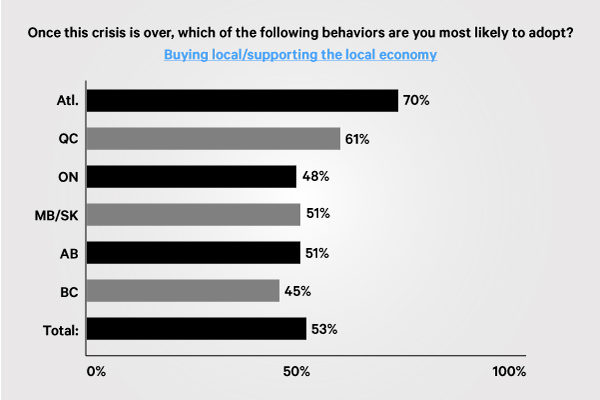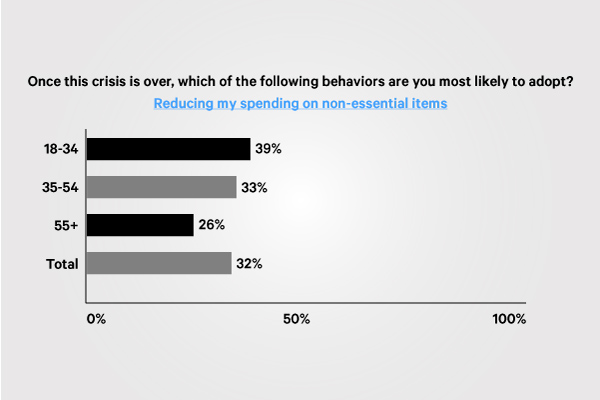Not so typical anymore: How will COVID-19 change Canadians’ behaviours?

Recommended articles
On related topics
This is week number 6 of confinement for me. Back before COVID-19 and remote work, I would typically catch an early commuter train to work, normally standing in a crowd near the exit, then head to my favourite café (Café Myriade) for a coffee or pastry to go. I might even squeeze into a seat at one of the café’s tiny bistro tables to check my emails before heading to the office—if every seat wasn’t already filled for business meetings.
Early in the morning, the elevators in our office building were never too crowded, but from 8:30 onward, it was a squeeze. There was usually a line-up for the coffee machine at work (thank you Keurig Dr Pepper!), and I might stop and chat with colleagues or skim through the newspapers set out on a table for all to share.
Our meeting rooms were always in high demand, as we have a very collaborative work environment. There were also business luncheons at downtown hotels with dozens of tables of 10 or 12 of us squeezed in to listen to a conference speaker, plus client meetings and business or pro bono events.
Depending on the day of the week, after my workday, I would either head to yoga or to the tennis courts at my health club, and we might grab a beer afterward. Occasionally, there would be an art show or museum visit, or perhaps dinner with friends at a lively downtown restaurant.
Just thinking about what used to be a “typical” day makes me not only nostalgic, but also leads me to wonder how much of this will no longer be “typical”. While I will be ready to run onto a tennis court the day the courts open for play, I will think twice about attending a stadium event. I may avoid the crowded exit on the train. I will definitely not be hanging on to escalator handrails and will avoid opening doors, if at all possible. But I sincerely hope that Café Myriade will have survived the crisis and be open for business, just like many of the other smaller local shops and cafés I frequent. And at NATIONAL, we will be there to help our clients make the transition.
To anticipate what the “new normal” might look like, I reached out to our friends at Leger to ask Canadians what behaviours they planned on maintaining post-COVID-19. Here are some of the key findings from a survey fielded from April 17 to 19 among 1,504 Canadians:
Local buying
Fully 53% plan to continue to buy local/support the local economy. For businesses operating in Quebec and Atlantic Canada, they will really have to demonstrate their local roots, because fully 61% of Quebecers and 70% of people in the Atlantic provinces plan on supporting their local businesses.

Long-distance travels
Local is a watchword for tourism as well: 21% of Canadians (28% of Quebecers) plan on avoiding long-distance travel. This is consistent across all age groups, younger and older. For airlines or tour operators, this might not be such good news, although they could see increased demand for destinations closer to home.
Social distancing
After weeks of confinement, people are craving human contact. 43% plan on spending more time with friends and family. Younger people between 18 and 34, in particular, will be seeking out their friends (48%). They will also be less likely to avoid large groups: While two in ten (21%) younger respondents say they will avoid crowded settings like sports events, concerts and festivals, among those 55 or older, twice as many (almost four in ten or 38%) plan on avoiding crowds. Event organizers who target this group will have to be extra vigilant about social distancing measures to convince their audience to show up.
Non essential spending
Retailers, beware! Fully one third (32%) of Canadians in all regions (women: 35%; people between 18 and 34: 39%) say they plan on reducing spending on non-essential items. Is our era of hyper-consumerism truly coming to an end, when Canadians, especially the younger generations, plan on reducing non-essential spending? How will we define what is “essential” and “non-essential”?

Online shopping
While many retailers rushed to make online shopping available to their customers during COVID-19, just 11% of Canadians said they will favour online shopping over shopping in stores post-COVID-19. This result is somewhat higher among 18- to 34-year-olds: 15%.
Preparing for future crises
28% of Canadians state that they will want to make sure their home is equipped to face similar crises in the future; this is particularly true for those aged 35 to 54 (those most likely to be homeowners), where 34% will be looking to make adjustments. Will the residential construction industry respond with dedicated office space in new homes and condos?
Remote work
Remote work does not appear to be particularly appealing: Only 11% of respondents said they would like to continue to work from home if their employer allows it. However, if you have a large pool of employees in the 18-to-34 age group, you may want to show more flexibility, since 19% would want to work from home.
While a survey is simply a snapshot in time, and Canadians may not have fully thought through their intentions yet, these results portend significant changes in consumer behaviour in the foreseeable future. Will business models and government policy be able to adjust accordingly? Only time will tell. Two things are for sure: We at NATIONAL will be here to help our clients transition to, and perhaps even capitalize on, the “new normal”—and I will be back on the train, heading to the office each morning.
——— Doris Juergens is a former Partner and National Vice-President, Strategy at NATIONAL Public Relations

